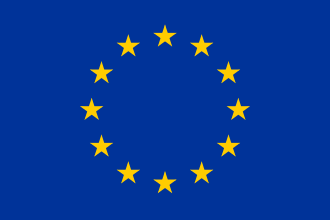![[ID: A lush green landscape, with a plane in flight casting a shadow over it. End ID]](https://pairamid.eu/wp-content/uploads/2025/06/alvaro-montoro-5EP06mUnKhk-unsplash-scaled.jpg)
Aviation is a cornerstone of the European economy, providing millions of jobs and supporting 4.4% of the EU’s GDP. However, it also remains one of the fastest-growing sources of greenhouse gas emissions, contributing approximately 3.8% to 4% of the EU’s total emissions in 2022. Given this state of affairs, and with air travel demand projected to double by 2050, the European Union has initiated a comprehensive strategy aimed at decarbonising the sector and aligning it with its broader climate objectives.
Central to this strategy is the European Green Deal, which aims for climate neutrality by 2050. To achieve this, the EU has set an interim target of reducing transport emissions by 90% by mid-century compared to 1990 levels. And, given its significant and growing emissions, this makes the aviation sector a critical focus area. Since 2012, the EU has required airlines operating in Europe to monitor, report, and verify their emissions, and to surrender allowances accordingly. Accompanying this has been the push for the market-based mechanism of the Emissions Trading System (ETS) meant to incentivise emission reductions and promote investment in cleaner technologies.
To further accelerate decarbonisation, the EU introduced several new initiatives focusing not only on Sustainable Aviation Fuels (SAFs) but also on alternative propulsion technologies and optimised flight operations. The ReFuelEU Aviation Regulation (October 2023) mandates a gradual increase in the share of Sustainable Aviation Fuels (SAF) blended into conventional aviation fuel at EU airports, starting from 2% in 2025 and due to reach 70% by 2050. While SAFs, derived from renewable sources like waste oils and biomass, can significantly reduce lifecycle CO₂ emissions compared to traditional jet fuels, current SAF production is limited, accounting for less than 0.05% of total EU aviation fuel usage, highlighting the need for rapid scale-up.
In addition, the EU is actively supporting the development of electrification and hydrogen‑powered aircraft. SESAR‑JU, as part of the Alliance for Zero‑Emission Aviation, is preparing the ecosystem for electric and hydrogen aircraft to enter service by 2035, addressing airport infrastructure, certification and safety issues, while the SESAR Advanced Research & Innovation Strategy outlines the vital role potentially played by electrification, hybridisation and hydrogen propulsion across all aviation segments, including regional and general aviation, to reach net‑zero by 2050.
Moreover, smarter air‑traffic management (ATM) is a key pillar of the strategy. The SESAR 3 Joint Undertaking is deploying digital solutions, such as 4D trajectory management and contrail‑avoidance systems, that optimise routes, reduce holding patterns and save fuel.
Complementing ReFuelEU is the Renewable and Low-Carbon Fuels Value Chain Industrial Alliance, established in April 2022. This initiative brings together stakeholders across the transport fuels value chain to enhance the production and supply of renewable and low-carbon fuels, particularly for aviation and maritime sectors.
By fostering collaboration between industry leaders, technology providers, and policymakers, the alliance aims to overcome supply constraints and support the EU’s decarbonisation goals.
In parallel, the Clean Aviation Joint Undertaking, under the Horizon Europe programme, is spearheading research and innovation to develop next-generation aircraft technologies. The revised Strategic Research and Innovation Agenda (SRIA) outlines a vision for aircraft concepts that can achieve at least a 30% reduction in net greenhouse gas emissions at the aircraft level by 2030, with technological readiness levels due to reach TRL 6. The European vision is to enable the launch of a new generation of products and services by 2035, aligning with the EU’s climate objectives by providing a quantum leap in efficiency and sustainability, and affirming the EU’s role as a global player and powerhouse in technology and sustainability.
This is further supported by the Destination 2050 initiative, a collaborative effort by European aviation stakeholders due to provide a comprehensive roadmap to achieve net-zero carbon emissions by 2050, and emphasising the importance of a multifaceted approach, combining improvements in aircraft and engine technologies, increased use of SAFs, operational efficiencies, and market-based measures.
While the EU’s policy framework lays a solid foundation for aviation decarbonisation, challenges remain. Critically, the Destination 2050 initiative underscores the urgency of immediate action, noting that delays in implementing these measures could jeopardise the sector’s ability to meet its climate targets. The limited availability and high cost of SAFs, technological hurdles in developing new aircraft, and the need for substantial investment across the sector also represent significant barriers yet to be fully overcome. Addressing these issues requires sustained commitment from all stakeholders, including governments, industry, and research institutions. By fostering innovation, enhancing collaboration, and ensuring supportive policies, Europe can lead the global transition to sustainable aviation.
The Horizon Europe Project pAIramid, a four-year effort to revolutionise the certification of composite aerostructures in aviation, plays its part here as well, by enabling faster integration of lightweight materials and greener manufacturing methods. Combining the use of AI-driven decision-making tools and a strong focus on sustainability, the project is poised to break new ground for aerospace technology and trace a path into a sustainable future.
Get in touch with pAIramid for any questions, project updates or to discuss potential collaborations.

This project has received funding from the European Union’s Horizon Europe research and innovation programme under grant agreement No 101192736.